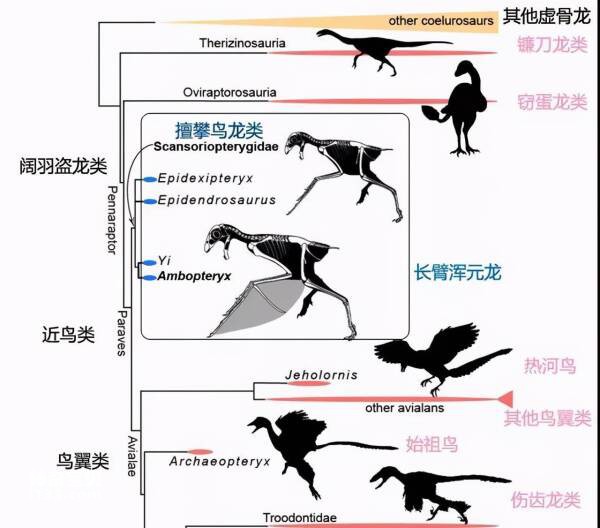1. Archaeopteryx specimens, gradient, evolution from dragon to bird
As more and more feathered dinosaurs and primitive bird fossils are discovered, scientists have found that there are more and more similarities between the two, such as body structure (size, bone healing degree, etc.), living habits (eating habits, feeding, etc.), life age, etc. Therefore, many dinosaur fossil species were mistaken for birds at the beginning of research, such as Sinosauropteryx, Protarchaeopteryx, Jinfengopteryx, etc.
And more and more scientific discoveries and research are blurring the boundaries between dinosaurs and birds. Is Archaeopteryx the oldest bird, or a feathered dinosaur? Perhaps the answer to this question is not important. What is important is the continuous evolutionary process composed of primitive bird fossils, including Archaeopteryx, and feathered dinosaur fossils, proving that birds originated from a small, feathered theropod dinosaur. In this gradual evolutionary process, birds evolved a series of characteristics adapted to flight, and finally conquered the blue sky.

2. Classification of living birds
According to the living environment and physical characteristics of the birds, birds of the general order Cytothorax (all extant birds except Ostriches, American Ostriches, Cassowaries, Apteryths, Synornithiformes, and Penguins) can be classified into ) are divided into six major ecological groups:
Migratory birds: Birds that can swim on the water surface and mainly cruise on the water surface, including ducks, geese, gulls, etc.
Wading birds: They wade in tidal flats and wetlands, but most of them cannot swim. They often have the characteristics of "three lengths" - long legs, long necks, and long beaks, including cranes, storks, shorebirds, etc.
Songbirds: Passerine birds, the most evolved group of birds.
Climbing birds: Birds that are adapted to climbing have mostly opposable or turned-toed feet, including woodpeckers, parrots, etc.
Land birds: Birds that live on the ground. Their physical characteristics are suitable for walking on the ground and their ability to fly is not strong. They include pheasants, quails, doves and pigeons, etc.
Birds of prey: Birds that feed on other animals and have characteristics adapted to hunting life, such as sharp claws and beaks, and keen vision. They mainly include hawks, falcons, harriers, ospreys, buzzards, owls, etc.
3. Functional inference of the origin of feathers
Functional inferences about the origin of feathers often revolve around the following three hypotheses: flight function; thermal insulation function; and sexual display function. The recent discovery of feathered dinosaurs from the Late Cretaceous in China demonstrates that feathers appear to have originated in a taxon that preserves a large number of primitive non-avian features. Recent evidence strongly points to birds being theropod dinosaurs, the most primitive feathers known to be found in flightless animals. This further suggests that the original function of feathers was not flight, so thermoregulation, sexual display and biomechanical support functions are still possible explanations for the origin of feathers. Since the earliest function of feathers was not for flying in the air, it can be inferred that the transitional animals recovered from fossils produced in China should have characteristics similar to reptile skin derivatives, which were later elongated and acquired the characteristics of feathers.
4. Radiation and adaptation of living birds
There are more than 9,000 species of living birds, belonging to 33 orders. They vary greatly in body size, body proportions, feather color, song styles and flight abilities. The largest living bird, the ostrich, weighs more than 60 kilograms and has completely lost the ability to fly. The smallest living bird, the hummingbird, weighs less than 30 grams. If calculated relative to its own body size, It is undoubtedly the fastest vertebrate in the world (flying 385 body lengths per second).
In order to adapt to different living environments, birds have evolved various body shapes. For example, wading birds often have the characteristics of "three lengths" - long legs, long necks, and long beaks due to their wading activities in tidal wetlands; In order to adapt to climbing life, the toes of birds are mostly opposable or turned-toed feet; raptors mostly have sharp claws and beaks adapted to hunting, as well as keen vision.
animal tags: archaeopteryx specimen gradient evolution
We created this article in conjunction with AI technology, then made sure it was fact-checked and edited by a Animals Top editor.